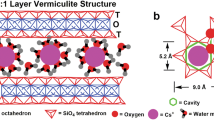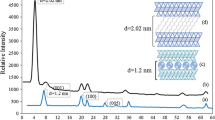Abstract
With the ultimate aim of reducing the volume of radioactive-cesium-contaminated soil generated by the nuclear power plant accident in Fukushima Prefecture in 2011, this study focuses on the desorption of Cs+ ions from minerals that strongly adsorb Cs+, such as clay, using the ion-association reagents sodium tetrakis(4-fluorophenyl)borate hydrate (NaTFPB) and sodium tetraphenylborate (NaTPB) under mild conditions. A-type zeolite was selected as a representative aluminosilicate mineral with a high cesium adsorption capacity. NaTFPB exhibits stronger hydrophobic interactions with Cs+ and improved Cs+ compared to NaTPB; a desorption efficiency of 89.4% was achieved at a 10:1 NaTFPB/cesium molar ratio.
Graphic abstract







Similar content being viewed by others
Abbreviations
- Cs:
-
Cesium
- NaTFPB:
-
Sodium tetrakis(4-fluorophenyl)borate
- NaTPB:
-
Sodium tetraphenylborate
References
Ministry of the Environment (2019) Volume reduction and recycling technology development strategy for intermediate storage and removal soil, etc. Review to achieve strategic goals. http://josen.env.go.jp/chukanchozou/facility/effort/investigative_commission/pdf/investigative_commission_review_1903.pdf. Accessed 21 April 2020
Ministry of the Environment (2020) Intermediate storage facility information site. http://josen.env.go.jp/chukanchozou/facility/effort/. Accessed 21 April 2020
Ministry of the Environment (2019) Current status and future plan of volume reduction and recycling technology demonstration: Understanding and evaluation of current technology. http://josen.env.go.jp/chukanchozou/facility/effort/investigative_commission/pdf/proceedings_191219_03-01.pdf. Accessed 27 April 2020
The National Institute of Advanced Industrial Science and Technology, Desorption method of cesium from soil, Japanese Unexamined Patent Publication No. 2013-050313, 2013-03-14
Toshiba Corporation, Method for treating radioactive cesium and radioactive strontium-containing substances, Japanese Unexamined Patent Publication No. 2013-088391, 2012-0513
Omori T, Sato T, Ishizuka H, Shiokawa T (1981) Reactions of cesium and rubidium with sodium tetrakis(p-fluorophenyl)borate. J Radioanal Chem 67(2):299–306. https://doi.org/10.1007/bf02516342
Sustacek V, Senkyr J (1990) Selectivity coefficients of univalent cations for liquid ion-exchange membrane electrodes based on nitrobenzene. J Electroanal Chem Interfacial Electrochem 279(1–2):31–41. https://doi.org/10.1016/0022-0728(90)85164-z
Kagan LM, Kadatsky VB (1996) Depth migration of Chernobyl originated 137Cs and 90Sr in soils of Belarus. J Environ Radioact 33(1):27–39. https://doi.org/10.1016/0265-931x(95)00068-l
Sasaki T, Terakado Y, Kobayashi T, Takagi I, Moriyama H (2007) Analysis of sorption behavior of cesium ion on mineral components of granite. J Nucl Sci Technol 44(4):641–648. https://doi.org/10.1080/18811248.2007.9711852
Van Loon LR, Glaus MA (2008) Mechanical compaction of smectite clays increases ion exchange selectivity for cesium. Environ Sci Technol 42(5):1600–1604. https://doi.org/10.1021/es702487m
Liu C, Li H, Teppen BJ, Johnston CT, Boyd SA (2009) Mechanisms associated with the high adsorption of dibenzo-p-dioxin from water by smectite clays. Environ Sci Technol 43(8):2777–2783. https://doi.org/10.1021/es802381z
Rana K, Boyd SA, Teppen BJ, Li H, Liu C, Johnston CT (2009) Probing the microscopic hydrophobicity of smectite surfaces: a vibrational spectroscopic study of dibenzo-p-dioxin sorption to smectite. Phys Chem Chem Phys 11(16):2976–2985. https://doi.org/10.1039/b822635k
Iijima K, Tomura T, Shoji Y (2010) Reversibility and modeling of adsorption behavior of cesium ions on colloidal montmorillonite particles. Appl Clay Sci 49(3):262–268. https://doi.org/10.1016/j.clay.2010.05.016
Yildiz B, Erten HN, Kis M (2011) The sorption behavior of Cs+ ion on clay minerals and zeolite in radioactive waste management: sorption kinetics and thermodynamics. J Radioanal Nucl Chem 288(2):475–483. https://doi.org/10.1007/s10967-011-0990-5
Yamaguchi N, Eguchi S, Fujiwara H, Hayashi K, Tsukada H (2012) Radiocesium and radioiodine in soil particles agitated by agricultural practices: field observation after the Fukushima nuclear accident. Sci Total Environ 425:128–134. https://doi.org/10.1016/j.scitotenv.2012.02.037
Park M, Kim H-J, Kim KS, Duckworth OW, Komarneni S (2012) Hydronium-promoted equilibrium mechanism for the alkali metal cation exchange reaction in Na-4-Mica. J Phys Chem C 116(35):18678–18683. https://doi.org/10.1021/jp300759n
Ding D, Lei Z, Yang Y, Feng C, Zhang Z (2013) Nickel oxide grafted andic soil for efficient cesium removal from aqueous solution: adsorption behavior and mechanisms. ACS Appl Mater Interfaces 5(20):10151–10158. https://doi.org/10.1021/am402836b
Su J-Y, Jin G-P, Chen T, Liu X-D, Chen C-N, Tian J-J (2017) The characterization and application of prussian blue at graphene coated carbon fibers in a separated adsorption and electrically switched ion exchange desorption processes of cesium. Electrochim Acta 230:399–406. https://doi.org/10.1016/j.electacta.2017.02.027
Qian J, Zhou L, Yang X, Hua D, Wu N (2020) Prussian blue analogue functionalized magnetic microgels with ionized chitosan for the cleaning of cesium-contaminated clay. J Hazard Mater. https://doi.org/10.1016/j.jhazmat.2019.121965
Murota K, Saito T, Tanaka S (2016) Desorption kinetics of cesium from Fukushima soils. J Environ Radioact 153:134–140. https://doi.org/10.1016/j.jenvrad.2015.12.013
Mukai H, Tamura K, Kikuchi R, Takahashi Y, Yaita T, Kogure T (2018) Cesium desorption behavior of weathered biotite in Fukushima considering the actual radioactive contamination level of soils. J Environ Radioact 190–191:81–88. https://doi.org/10.1016/j.jenvrad.2018.05.006
Yin X, Horiuchi N, Utsunomiya S, Ochiai A, Takahashi H, Inaba Y, Wang X, Ohnuki T, Takeshita K (2018) Effective and efficient desorption of Cs from hydrothermal-treated clay minerals for the decontamination of Fukushima radioactive soil. Chem Eng J 333:392–401. https://doi.org/10.1016/j.cej.2017.09.199
Sato K, Zhao Y, Kamaya M (2019) Structural reconfigurations of nanosheet arrays in layered minerals caused by wave irradiation: desorption mechanism of Cs from nanosheet edges. Phys Chem Chem Phys 21(29):16345–16352. https://doi.org/10.1039/c9cp03685g
Park CW, Kim BH, Yang H-M, Seo B-K, Moon J-K, Lee K-W (2017) Removal of cesium ions from clays by cationic surfactant intercalation. Chemosphere 168:1068–1074. https://doi.org/10.1016/j.chemosphere.2016.10.102
Park CW, Kim BH, Yang H-M, Seo B-K, Lee K-W (2017) Enhanced desorption of Cs from clays by a polymeric cation-exchange agent. J Hazard Mater 327:127–134. https://doi.org/10.1016/j.jhazmat.2016.12.037
Lima E, Ibarra IA, Lara V, Bosch P, Bulbulian S (2008) Cesium leaching from gamma-irradiated CsA and CsX zeolites. J Hazard Mater 160(2–3):614–620. https://doi.org/10.1016/j.jhazmat.2008.03.035
Yoshida K, Toyoura K, Matsunaga K, Nakahira A, Kurata H, Ikuhara YH, Sasaki Y (2013) Atomic sites and stability of Cs+ captured within zeolitic nanocavities. Sci Rep 3:2457. https://doi.org/10.1038/srep02457
Motomizu S (2003) Ion association and analytical chemistry. Bunseki 12:734–736
Kumagai S, Hayashi K, Kameda T, Yoshioka T (2016) Removal and condensation of cesium ion from water phase into ionic associate phase using tetraphenylborate. J Soc Remediat Radioact Contam Environ 4(3):239–245
Igarashi S, Yotsuyanagi T (1992) Homogeneous liquid-liquid extraction by pH dependent phase separation with a fluorocarbon ionic surfactant and its application to the preconcentration of porphyrin compounds. Mikrochim Acta 106(1–2):37–44. https://doi.org/10.1007/bf01242697
Yokohashi G, Igarashi S (1997) Effect of the form of the quaternary ammonium ion on the ion-pair phase separation phenomenon with perfluorooctanoic acid. J Colloid Interface Sci 185(1):278–280. https://doi.org/10.1006/jcis.1996.4543
Takahashi A, Ueki Y, Igarashi S (1999) Homogeneous liquid-liquid extraction of uranium(VI) from acetate aqueous solution. Anal Chim Acta 387(1):71–75. https://doi.org/10.1016/s0003-2670(99)00038-0
Haruyama K, Ashizawa T (1965) Tetraphenylboron solvent extraction of cesium and francium. Jpn Anal 14:120–124. https://doi.org/10.2116/bunsekikagaku.14.120
Rogers H, Bowers J, Gates-Anderson D (2012) An isotope dilution-precipitation process for removing radioactive cesium from wastewater. J Hazard Mater 243:124–129. https://doi.org/10.1016/j.jhazmat.2012.10.006
Soliman MA, Rashad GM, Mahmoud MR (2015) Fast and efficient cesium removal from simulated radioactive liquid waste by an isotope dilution-precipitate flotation process. Chem Eng J 275:342–350. https://doi.org/10.1016/j.cej.2015.03.136
Ponder SM, Mallouk TE (1999) Recovery of ammonium and cesium ions from aqueous waste streams by sodium tetraphenylborate. Ind Eng Chem Res 38(10):4007–4010. https://doi.org/10.1021/ie990239s
Tamura K, Sato H, Yamagishi A (2014) Desorption of Cs+ ions from a vermiculite by exchanging with Mg2+ ions: effects of Cs+-capturing ligand. J Radioanal Nucl Chem. https://doi.org/10.1007/s10967-014-3744-3
Kobayashi H (1987) Specialties of fluorine compounds and their analytical utilizations. Synth Org Chem 45(6):561–570. https://doi.org/10.5059/yukigoseikyokaishi.45.561
Shannon RD (1976) Revised effective ionic radii and systematic studies of interatomic distances in halides and chalcogenides. Acta Crystallogr Sect A Cryst Phys Diffr Theor Gen Crystallogr A32(5):751–767. https://doi.org/10.1107/s0567739476001551
Frisch MJ, Trucks GW, Schlegel HB, Scuseria GE, Robb MA, Cheeseman JR, Montgomery Jr JA, Vreven T, Kudin KN, Burant JC, Millam JM, Iyengar SS, Tomasi J, Barone V, Mennucci B, Cossi M, Scalmani G, Rega N, Petersson GA, Nakatsuji H, Hada M, Ehara M, Tpyota K, Fukuda R, Hasegawa J, Ishida M, Nakajima T, Honda Y, Kitao O, Nakai H, Klene M, Li X, Knox JE, Hratchian HP, Cross JB, Bakken V, Adamo C, Jaramillo J, Gomperts R, Stratmann RE, Yazyev O, Austin AJ, Cammi R, Pomelli C, Ochterski JW, Ayala PY, Morokuma K, Voth GA, Salvador P, Dannenberg JJ, Zakrzewski VG, Dapprich S, Daniels AD, Strain MC, Farkas O, Makick DK, Rabuck AD, Raghavachari K, Foresman JB, Ortiz JV, Cui Q, Baoul AG, Clifford S, Cioslowski J, Stefanov BB, Liu G, Liashenko A, Piskorz P, Komaromi I, Martin RL, Fox DJ, Keith T, Al-Laham MA, Peng CY, Nanayakkara A, Challacombe M, Gill PMW, Johnson B, Chen W, Wong MW, Gonzalez C, Pople JA (2004) Gaussian03, revision 3.09. Gaussian, Inc., Wallingford, CT
Acknowledgements
This work was supported by the Japan Society for the Promotion of Science (KAKENHI Grant Number 17K20058).
Author information
Authors and Affiliations
Corresponding author
Ethics declarations
Conflict of interest
The authors declare that they have no known competing financial interests or personal relationships that could have appeared to influence the work reported in this paper.
Additional information
Publisher's Note
Springer Nature remains neutral with regard to jurisdictional claims in published maps and institutional affiliations.
Electronic supplementary material
Below is the link to the electronic supplementary material.
Rights and permissions
About this article
Cite this article
Saito, Y., Shimizu, S., Kumagai, S. et al. Removal of cesium ions from A-type zeolites using sodium tetrakis(4-fluorophenyl)borate and sodium tetraphenylborate. J Radioanal Nucl Chem 327, 337–344 (2021). https://doi.org/10.1007/s10967-020-07514-w
Received:
Accepted:
Published:
Issue Date:
DOI: https://doi.org/10.1007/s10967-020-07514-w




